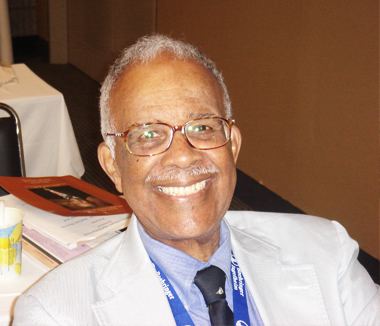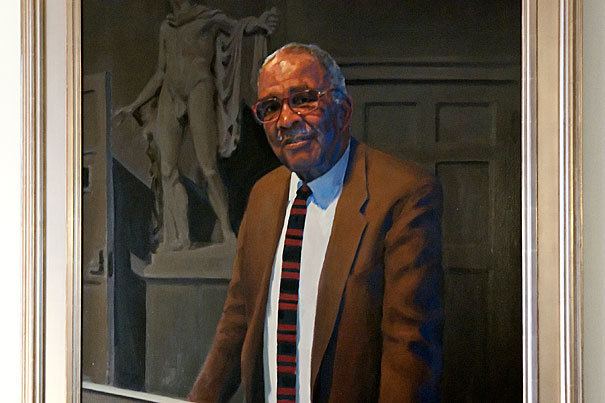Name Chester Pierce | Education Harvard University | |
 | ||
Full Name Chester Middlebrook Pierce Known for Harvard University Professor | ||
Chester Middlebrook Pierce was Emeritus Professor of Education and Psychiatry at Harvard Medical School. He was the first African-American full professor at Massachusetts General Hospital, and was past-president of the American Board of Psychiatry and Neurology and the American Orthopsychiatric Association. He was a fellow in the American Academy of Arts and Sciences.
Contents
- Personal and biographical information
- Discussion of major area of work
- Suppressed Anger and Blood Pressure The Effects of Race Sex Social Class Obesity and Age 1986
- On The Meaning of Sports Cross Cultural Observations of Super Stress 1982
- References

Personal and biographical information

Chester Pierce was born on March 4, 1927 in Glen Cove, New York. At the time, only 10% of the 8,000 residents were African Americans. Pierce became the first African American president of his high school. In 1948, he received his A.B. degree from Harvard College and in 1952 he received his M.D. degree from the Harvard Medical School. After medical school, Pierce trained as a psychiatrist in Cincinnati, Ohio.

Pierce was the first African American college football athlete to perform on the playing field of a predominantly-white university versus an all white team below the Mason–Dixon. Harvard's opponent was University of Virginia, October 11, 1947, before a crowd of 22,000.

Pierce died on September 23, 2016.
Discussion of major area of work

Pierce is a professor of education and psychiatry at Harvard Medical School. He became the first African-American full professor at the Massachusetts General Hospital. Pierce is the past president of the American Board of Psychiatry and Neurology in the American Orthopsychiatric Association and is now a fellow in the American Academy of Arts and Sciences. From 2001-2004 he was on the Carter Center Mental Health Task force and a founding president of the Black Psychiatrists of America. During that time he was also the National Chairperson of the Child Development Associate Consortium. He spent much of his career as a Senior Psychiatrist at Massachusetts General Hospital, and worked as a psychiatrist at the Massachusetts Institute of Technology for 25 years.

Pierce was an officer with Commander rank in the U.S. Navy. and has since been a senior consultant to multiple different health-related organizations. While he has been a part of 22 different editorial boards. He participated in the World Association of Social Psychiatry. Much of his time is spent working with organizations that help to promote human rights, conservation, and youth education. He has been a consultant for the Children's Television Network, the Surgeon General of the U.S. Air Force, the US Arctic Research Commission, the Peace Corps, and the National Aeronautics and Space Administration. While at Harvard he was quoted saying, "Every child in American entering school at the age of 5 is mentally ill because he comes to school with certain allegiances to our founding fathers, toward our elected officials, toward his parents, toward a belief in a supernatural being, and toward the sovereignty of this nation as a separate entity. It's up to you as teacher to make all these sick children well – by creating the international child of the future".
Pierce has published over 180 books, articles, and reviews. In 1998, he was the topic of the book titled Race and Excellence: My Dialogue with Chester Pierce by Ezra E.H. Griffith. His work mostly surrounds areas of racism, societal tensions, sports medicine, and the media. He is a member of the Institute of Medicine at the National Academy of Sciences as well as at the American Academy of Arts and Science. Pierce frequently offers his time as a guest lecturer and has given talks at over 100 universities in the United States alone. Although Pierce retired as a psychiatrist in 1997, one of his most recent accomplishments came in 2002 when he organized an "African Diaspora" conference that brought psychiatrists from all around the globe to discuss issues and problems. Because of his efforts, the MGH Division of International Psychiatry was founded in 2003. The Harvard Foundation also commissioned a portrait of Pierce, which now hangs in the residence hall in which he lived as an undergraduate at Harvard.
Suppressed Anger and Blood Pressure: The Effects of Race, Sex, Social Class, Obesity, and Age (1986)
This study consisted of 572 men and women who agreed to fill out a questionnaire that measured conflict over anger expression. The premise of the experiment was to see if "pent up anger" and the inability to express one self has an effect on health and blood pressure. In the past, it has been shown that hypertension is most prevalent in lower social classes and among those experiencing a high degree of social disruption. Their systolic blood pressures were then record and conclusions were drawn about suppressed anger and its relationship to blood pressure. Across all of the subjects, blood pressure was significantly related to suppressed anger. After the researchers controlled age, social class, and obesity, the relationship remained. The relationship between suppressed anger and gender then varied. There was a significant relationship for white men, a trend shown for black men, and no significance between the two in women. The study took place at an unemployment office, and was set up to offer free blood pressure screenings. The participants were then briefly seated, and asked to fill out a questionnaire that asked about certain demographic and health information. They were then asked about a hypothetical situation in which they had to decide how they would deal with anger they felt, either by holding it in or expressing it outwardly. A three-point scale was then determined for the ability to express anger, and these scores were compared to the blood pressure results. In all of the analyses, diastolic pressure was not related to suppressed anger. Systolic blood pressure, however, was found to be significantly related to suppressed anger, even after controlling for age, social class, and obesity.
Overall, this study supports the idea that suppressed anger is related to hypertension. As admitted in the discussion, the relationship between anger and Black participants was not studied enough. The original form that included inquiries about suppressed anger introduced a scenario where the participant was engaged by a police officer and harassed for something that was not the participant's fault. In the United States, it is believed that African-American's are more likely to be stopped and harassed by law enforcement than other races. This should have been studied closer and examined in relationship to blood pressure. In general, the study was straightforward and had a clear goal. One critique is that the report of the study should have included more information about how the researchers were able to control for social class, age, and obesity when analyzing the results.
On The Meaning of Sports: Cross Cultural Observations of Super Stress (1982)
This study compared two culturally different sporting events that take place. The first was the 250-mile foot race done by the Tarahumara Indians in the Sierra Madre Occidentale. The race is done in teams and consists of groups of people kicking a small wooden ball in front of them for 250 miles. The runners stop every four to six hours for a 45-minute break. The fans follow the participants along the way, carrying torches, and even running 10-15 mile segments with the team. The other event was the 1,049-mile dog sled race across Alaska, the Iditarod. This race is conducted in below freezing temperatures. Participants are subjected to limited sleep and physical trauma. The purpose of this study is to compare sports cross-culturally, and to clarify the common origins, purposes, and meanings of sport, while indicating behavioral and attitudinal discrepancies.
Thirteen factors were compared between the two groups. Medical care was found to be much more prevalent, but less effective, in the Iditarod. The origin of the race in Mexico was found to be at least several centuries old, while the Iditarod is less than a decade in age. The purpose of the events were found to be more spiritual and religious in the Mexican race, and more of a testament to testing limits as well as honoring a life-saving dog sled journey in 1925. While the gender of participants is open to any in both races, the 250-mile race has been that way for a much longer time whereas a woman first completed the Iditarod in 1978. While both races are extremely taxing financially, the Mexican race allows their competitors to bet on the race, unlike America where players are always barred from placing bets. The Tarahumaran race is uni-cultural in the sense that only Tarahumarans can run it and everyone else is seen as futile, while the Iditarod is seen as multi-cultural because of its acceptance of all participants. The gear requirements also vary greatly, as the Iditarod is a constant battle to maintain and facilitate the musher's gear, whereas the "kickball" game is done in every day clothes and the majority of economic expenses are due to preparation of their celebratory fermented beverages. The kickball game is far more community-oriented because it is done in a 25-mile circuit, where as the Iditarod travels a sprint through more than 1,000 miles of vast Alaskan wilderness with no support available. The preparation also varies greatly in that the kickball game takes a life-time of preparation, while the Iditarod can be picked up in one's late thirties. Because of the extreme nature of both sports, the comparison in regulations is not much different as both consist of many judges and controlling factors. The only difference in the starting of the races is the openness in betting. While the Iditarod consists of privately placed wagers, the celebratory nature of kickball shows everyone constantly betting in the open. The dangerous natures of the races are both very high. While the Mexican footrace has a smaller are and consists of more community, the Iditarod has deadly factors like wild animals and negative sixty-degree temperatures. And lastly, both of the races have extreme post-race celebrations that take place for multiple days and celebrate the accomplishments of all participants.
In conclusion, the study gathered a wide range of information and tried to weed out what overlapped and what separated the two cultures. Many analyses were made, but the biggest positive aspect of the study was the researchers ability to not become biased in any way toward an American way of thinking. They were consistently impartial and able to praise the positive aspects from both studies, even if they didn't correlate to a more modern way of thinking. While the study didn't gather any quantitative data, it was very expansive and informative. The ground chose to compare two cultures were very interesting and provided much more information about the groups than the surface would have shown.
